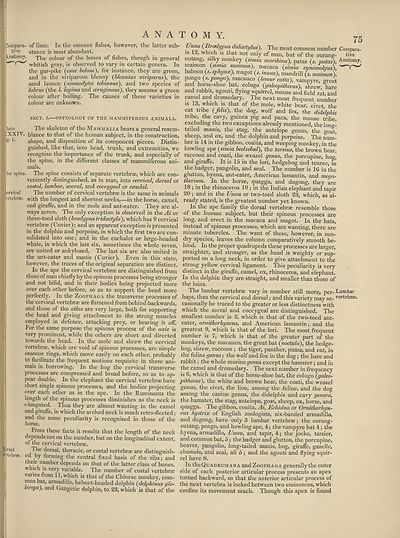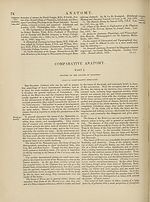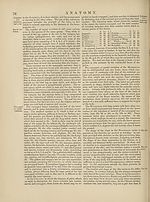Encyclopaedia Britannica > Volume 3, Anatomy-Astronomy
(83) Page 75
Download files
Complete book:
Individual page:
Thumbnail gallery: Grid view | List view

ANATOMY.
Compara¬
tive
Vnatomy.
75
late
i:xxiv.
<r. 1.
he spine
ervical
rtebrae.
ofhme. In the osseous fishes, however, the latter sub- Vnau {BrMypmdidactytui). The most common number Compara.
stance ts most abundant. >s "'hml, ls that not only of man, but of the ourane- live
The colour of the bones of fishes, though in general outang, silky monkey {simia marikina\ patas (s vatas) Anatomy
whitish gray, is observed to vary in certain genera. In maimon (simin maimon), macaca (simia ajmmolqus),
the gar-pike (esox below), for instance, they are green, baboon (s. sphynx), magot (s. mum), mandrill (s maimon)
and in the viviparous blenny (blenmus vtvtparm), the pongo (s.pmujo), niacauco (lemur catta), vamnvre ureat
sand launce (ammodytes tobianus), and two species of and horse-shoe bat, colugo (galeopithecus) shrew hare
labrus (the l. lapina and (eruginosa), they assume a green and rabbit, agouti, flying squirrel, mouse and field rat and
colour after boiling. The causes of these varieties in camel and dromedary. The next most frequent number
is 13, which is that of the mole, white bear, civet, the
cat tribe (felis), the dog, wolf and fox, the didelpfiis
tribe, the cavy, guinea pig and paca, the mouse tribe,
excluding the two exceptions already mentioned, the long¬
tailed manis, the stag, the antelope genus, the o^at,
sheep, and ox, and the dolphin and porpoise. The num¬
ber is 14 in the gibbon, coaita, and weeping monkey, in the
colour are unknown.
SECT. I.—OSTEOLOGY OF THE MAMMIFEROUS ANIMALS.
The skeleton of the Mammalia bears a general resem¬
blance to that of the human subject, in the construction,
shape, and disposition of its component pieces. Distin-
rsal
ftebrae.
,7 i . ~ r ^<„uaiLa, cuju weeping monxey, m the
guishea, like that, into head, trunk, and extremities, we howling ape (simia beelzebul), the tarsius, the brown bear
recognise the importance of the trunk, and especially of raccoon and coati, the weazel genus, the porcupine, ho£^,
the snine, in the different classes of mammiferrms nnl. and giraffe. It is 15 in the lori, hedgehog and tenrec, in
the badger, pangolin, and seal. The number is 16 in the
glutton, hyena, ant-eater, American lamantin, and mega¬
therium. In the horse, quagga, and dugong, they are
18 ; in the rhinoceros 19 ; in the Indian elephant and tapir
20; and in the Unau or two-toed sloth 23, which, as al¬
ready stated, is the greatest number yet known.
In the ape family the dorsal vertebrae resemble those
of the human subject, but their spinous processes are
long, and erect in the macaca and magot. In the bats,
instead of spinous processes, which are wanting, there are
the spine, in the different classes of mammiferous ani¬
mals.
The spine consists of separate vertebrae, which are con¬
veniently distinguished, as in man, into cervical, dorsal or
costal, lumbar, sacral, and coccygeal or caudal.
The number of cervical vertebrae is the same in animals
with the longest and shortest necks,—in the horse, camel,
and giraffe, and in the mole and ant-eater. They are al¬
ways seven. The only exception is observed in the Ai or
three-toed sloth (bradypus tridactyld), which has 9 cervical
vertebrae (Cuvier); and an apparent exception is presented
\ s ' ” rr— x ^ wiicuc wcumxig, mere an
in the dolphin and porpoise, in which the first two are con- minute tubercles. The want of these, however, in sun-
solidated into one; and in the cachalot or large-headed dry species, leaves the column comparatively smooth be-
whale, in which the last six. sometimes the whole cpv£»n llinrl- Tn til^ TAmr\ov /nmorlviimx/Ja 1
whale, in which the last six, sometimes the whole seven,
are united or ankylosed. The last six are also united in
the ant-eater and manis (Cuvier). Even in this state,
however, the traces of the original separation are distinct.
In the ape the cervical vertebrae are distinguished from
hind. In the proper quadrupeds these processes are larger,
straighter, and stronger, as the head is weighty or sup¬
ported on a long neck, in order to give attachment to the
strong yellow cervical ligament. This peculiarity is very
-r- Hum distinct in the giraffe, camel, ox, rhinoceros, and elephant.
those of man chiefly by the spinous processes being stronger In the dolphin they are straight, and smaller than those of
and not bifid, and in their bodies being projected more the loins.
over each other before, so as to support the head more The lumbar vertebrae vary in number still more, per-I'umbar
perfectly. In the Zoophaga the transverse processes of haps, than the cervical and dorsal; and this variety may oc- vertel>r£e.
the cervical vertebrae are flattened from behind backwards, casionally be traced to the greater or less distinctness with
and those of the atlas are very large, both for supporting which the sacral and coccygeal are distinguished. The
the head and giving attachment to the strong muscles smallest number is 2, which is that of the two-toed ant-
eater, ornithorhyncus, and American lamantin; and the
greatest 9, which is that of the lori. The most frequent
number is 7, which is that of the greater part of the
monkeys, the macauco, the great bat (noctula), the hedge¬
hog, shrew, raccoon ; the tiger, panther, puma, and cat, in
the feline genus; the wolf and fox in the dog; the hare and
rabbit; the whole murine genus except the hamster; and in
the camel and dromedary. The next number in frequency
is 6, which is that of the horse-shoe bat, the colugo (galeo-
employed in defence, attacking prey, or bearing it off.
For the same purpose the spinous process of the axis is
very prominent, while the others are short and directed
towards the head. In the mole and shrew the cervical
vertebrae, which are void of spinous processes, are simple
osseous rings, which move easily on each other, probably
to facilitate the frequent motions requisite in these ani¬
mals in burrowing. In the hog the cervical transverse
processes are compressed and broad before, so as to ap-
a # 7 1 7 ^ I/Aac iiwi oc-oiiuc Uctt, 111C UUiLlgU KUIAICO-
pear double. In the elephant the cervical vertebrae have pithecus), the white and brown bear, the coati, the weasel
snort Single spinous nrocesses. and thp hndips nrmppti'no- o-cmne klio r„l- .1 ]
short single spinous processes, and the bodies projecting
over each other as in the ape. In the Ruminants the
length of the spinous processes diminishes as the neck is
elongated. Thus they are almost wanting in the camel
and giraffe, in which the arched neck is much retro-flected;
genus, the civet, the lion, among the feline, and the dog
among the canine genus, the didelphis and cavy genera,
the hamster, the stag, antelope, goat, sheep, ox, horse, and
quagga. The gibbon, coaita, Ai, Echidna or Ornithorhyn¬
cus hystrix of English zoologists, six-banded armadillo,
i ... . uvu .71 A-iiigxiDu puuiugious, ,siA.-ua,iiueu aimauiiio,
and the same peculiarity is recognised in those of the and dugong, have only 3 lumbar vertebrae; the ourang-
10tn’ ,, . , , , . outangj pongo, and howling ape, 4; the vampyre bat 4; the
I-rom these facts it results that the length of the neck hyena, armadillo, Unau, and tapir, 4; the jocko, tarsier,
C,c n6n S n°^ 0It1 * 10 nurnker’ hot on the longitudinal extent, and common bat, 5; the badger and glutton, the porcupine,
° Tjf C?lvicf vertebrae. beaver, pangolin, long-tailed manis, hog, giraffe, gazelle,
j i e f.01^ ’ ^ 'oracic, or costal vertebrae are distinguish- chamois, and seal, all 5 ; and the agouti and flying squir¬
ed by forming the central fixed basis of the ribs; and rel have 8.
^ n?im^)er depends on that of the latter class of bones, In theQuADRUMANA and Zoophaga generally the outer
•C ^ if very variable. I he number of costal vertebrae side of each posterior articular process presents an apex
nes 10m , which is that of the Chinese monkey, com- turned backward, so that the anterior articular process of
mon a , arnia i o, helmet-headed dolphin (delphinus glo- the next vertebra is locked between two eminences, which
iceps), am angetic dolphin, to 23, which is that of the confine its movement much. Though this apex is found
Compara¬
tive
Vnatomy.
75
late
i:xxiv.
<r. 1.
he spine
ervical
rtebrae.
ofhme. In the osseous fishes, however, the latter sub- Vnau {BrMypmdidactytui). The most common number Compara.
stance ts most abundant. >s "'hml, ls that not only of man, but of the ourane- live
The colour of the bones of fishes, though in general outang, silky monkey {simia marikina\ patas (s vatas) Anatomy
whitish gray, is observed to vary in certain genera. In maimon (simin maimon), macaca (simia ajmmolqus),
the gar-pike (esox below), for instance, they are green, baboon (s. sphynx), magot (s. mum), mandrill (s maimon)
and in the viviparous blenny (blenmus vtvtparm), the pongo (s.pmujo), niacauco (lemur catta), vamnvre ureat
sand launce (ammodytes tobianus), and two species of and horse-shoe bat, colugo (galeopithecus) shrew hare
labrus (the l. lapina and (eruginosa), they assume a green and rabbit, agouti, flying squirrel, mouse and field rat and
colour after boiling. The causes of these varieties in camel and dromedary. The next most frequent number
is 13, which is that of the mole, white bear, civet, the
cat tribe (felis), the dog, wolf and fox, the didelpfiis
tribe, the cavy, guinea pig and paca, the mouse tribe,
excluding the two exceptions already mentioned, the long¬
tailed manis, the stag, the antelope genus, the o^at,
sheep, and ox, and the dolphin and porpoise. The num¬
ber is 14 in the gibbon, coaita, and weeping monkey, in the
colour are unknown.
SECT. I.—OSTEOLOGY OF THE MAMMIFEROUS ANIMALS.
The skeleton of the Mammalia bears a general resem¬
blance to that of the human subject, in the construction,
shape, and disposition of its component pieces. Distin-
rsal
ftebrae.
,7 i . ~ r ^<„uaiLa, cuju weeping monxey, m the
guishea, like that, into head, trunk, and extremities, we howling ape (simia beelzebul), the tarsius, the brown bear
recognise the importance of the trunk, and especially of raccoon and coati, the weazel genus, the porcupine, ho£^,
the snine, in the different classes of mammiferrms nnl. and giraffe. It is 15 in the lori, hedgehog and tenrec, in
the badger, pangolin, and seal. The number is 16 in the
glutton, hyena, ant-eater, American lamantin, and mega¬
therium. In the horse, quagga, and dugong, they are
18 ; in the rhinoceros 19 ; in the Indian elephant and tapir
20; and in the Unau or two-toed sloth 23, which, as al¬
ready stated, is the greatest number yet known.
In the ape family the dorsal vertebrae resemble those
of the human subject, but their spinous processes are
long, and erect in the macaca and magot. In the bats,
instead of spinous processes, which are wanting, there are
the spine, in the different classes of mammiferous ani¬
mals.
The spine consists of separate vertebrae, which are con¬
veniently distinguished, as in man, into cervical, dorsal or
costal, lumbar, sacral, and coccygeal or caudal.
The number of cervical vertebrae is the same in animals
with the longest and shortest necks,—in the horse, camel,
and giraffe, and in the mole and ant-eater. They are al¬
ways seven. The only exception is observed in the Ai or
three-toed sloth (bradypus tridactyld), which has 9 cervical
vertebrae (Cuvier); and an apparent exception is presented
\ s ' ” rr— x ^ wiicuc wcumxig, mere an
in the dolphin and porpoise, in which the first two are con- minute tubercles. The want of these, however, in sun-
solidated into one; and in the cachalot or large-headed dry species, leaves the column comparatively smooth be-
whale, in which the last six. sometimes the whole cpv£»n llinrl- Tn til^ TAmr\ov /nmorlviimx/Ja 1
whale, in which the last six, sometimes the whole seven,
are united or ankylosed. The last six are also united in
the ant-eater and manis (Cuvier). Even in this state,
however, the traces of the original separation are distinct.
In the ape the cervical vertebrae are distinguished from
hind. In the proper quadrupeds these processes are larger,
straighter, and stronger, as the head is weighty or sup¬
ported on a long neck, in order to give attachment to the
strong yellow cervical ligament. This peculiarity is very
-r- Hum distinct in the giraffe, camel, ox, rhinoceros, and elephant.
those of man chiefly by the spinous processes being stronger In the dolphin they are straight, and smaller than those of
and not bifid, and in their bodies being projected more the loins.
over each other before, so as to support the head more The lumbar vertebrae vary in number still more, per-I'umbar
perfectly. In the Zoophaga the transverse processes of haps, than the cervical and dorsal; and this variety may oc- vertel>r£e.
the cervical vertebrae are flattened from behind backwards, casionally be traced to the greater or less distinctness with
and those of the atlas are very large, both for supporting which the sacral and coccygeal are distinguished. The
the head and giving attachment to the strong muscles smallest number is 2, which is that of the two-toed ant-
eater, ornithorhyncus, and American lamantin; and the
greatest 9, which is that of the lori. The most frequent
number is 7, which is that of the greater part of the
monkeys, the macauco, the great bat (noctula), the hedge¬
hog, shrew, raccoon ; the tiger, panther, puma, and cat, in
the feline genus; the wolf and fox in the dog; the hare and
rabbit; the whole murine genus except the hamster; and in
the camel and dromedary. The next number in frequency
is 6, which is that of the horse-shoe bat, the colugo (galeo-
employed in defence, attacking prey, or bearing it off.
For the same purpose the spinous process of the axis is
very prominent, while the others are short and directed
towards the head. In the mole and shrew the cervical
vertebrae, which are void of spinous processes, are simple
osseous rings, which move easily on each other, probably
to facilitate the frequent motions requisite in these ani¬
mals in burrowing. In the hog the cervical transverse
processes are compressed and broad before, so as to ap-
a # 7 1 7 ^ I/Aac iiwi oc-oiiuc Uctt, 111C UUiLlgU KUIAICO-
pear double. In the elephant the cervical vertebrae have pithecus), the white and brown bear, the coati, the weasel
snort Single spinous nrocesses. and thp hndips nrmppti'no- o-cmne klio r„l- .1 ]
short single spinous processes, and the bodies projecting
over each other as in the ape. In the Ruminants the
length of the spinous processes diminishes as the neck is
elongated. Thus they are almost wanting in the camel
and giraffe, in which the arched neck is much retro-flected;
genus, the civet, the lion, among the feline, and the dog
among the canine genus, the didelphis and cavy genera,
the hamster, the stag, antelope, goat, sheep, ox, horse, and
quagga. The gibbon, coaita, Ai, Echidna or Ornithorhyn¬
cus hystrix of English zoologists, six-banded armadillo,
i ... . uvu .71 A-iiigxiDu puuiugious, ,siA.-ua,iiueu aimauiiio,
and the same peculiarity is recognised in those of the and dugong, have only 3 lumbar vertebrae; the ourang-
10tn’ ,, . , , , . outangj pongo, and howling ape, 4; the vampyre bat 4; the
I-rom these facts it results that the length of the neck hyena, armadillo, Unau, and tapir, 4; the jocko, tarsier,
C,c n6n S n°^ 0It1 * 10 nurnker’ hot on the longitudinal extent, and common bat, 5; the badger and glutton, the porcupine,
° Tjf C?lvicf vertebrae. beaver, pangolin, long-tailed manis, hog, giraffe, gazelle,
j i e f.01^ ’ ^ 'oracic, or costal vertebrae are distinguish- chamois, and seal, all 5 ; and the agouti and flying squir¬
ed by forming the central fixed basis of the ribs; and rel have 8.
^ n?im^)er depends on that of the latter class of bones, In theQuADRUMANA and Zoophaga generally the outer
•C ^ if very variable. I he number of costal vertebrae side of each posterior articular process presents an apex
nes 10m , which is that of the Chinese monkey, com- turned backward, so that the anterior articular process of
mon a , arnia i o, helmet-headed dolphin (delphinus glo- the next vertebra is locked between two eminences, which
iceps), am angetic dolphin, to 23, which is that of the confine its movement much. Though this apex is found
Set display mode to:
![]() Universal Viewer |
Universal Viewer | ![]() Mirador |
Large image | Transcription
Mirador |
Large image | Transcription
Images and transcriptions on this page, including medium image downloads, may be used under the Creative Commons Attribution 4.0 International Licence unless otherwise stated. ![]()
| Encyclopaedia Britannica > Encyclopaedia Britannica > Volume 3, Anatomy-Astronomy > (83) Page 75 |
|---|
| Permanent URL | https://digital.nls.uk/193758427 |
|---|
| Attribution and copyright: |
|
|---|---|
| Shelfmark | EB.16 |
|---|---|
| Description | Ten editions of 'Encyclopaedia Britannica', issued from 1768-1903, in 231 volumes. Originally issued in 100 weekly parts (3 volumes) between 1768 and 1771 by publishers: Colin Macfarquhar and Andrew Bell (Edinburgh); editor: William Smellie: engraver: Andrew Bell. Expanded editions in the 19th century featured more volumes and contributions from leading experts in their fields. Managed and published in Edinburgh up to the 9th edition (25 volumes, from 1875-1889); the 10th edition (1902-1903) re-issued the 9th edition, with 11 supplementary volumes. |
|---|---|
| Additional NLS resources: |
|

